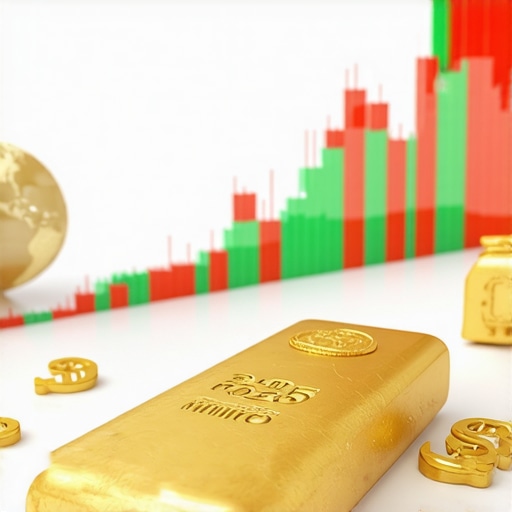Unearthing the Dynamics Behind Gold Demand: What Fuels the Precious Metal’s Allure?
Gold has captivated investors and civilizations alike for centuries, but understanding the intricate trends driving its demand is essential for those looking to grasp its price movements. The complex interplay of economic, geopolitical, and cultural factors continuously shapes gold’s market trajectory, making it a unique asset that reflects global uncertainties and aspirations.
From Jewelry to Central Banks: Diverse Drivers Behind Gold Demand
Gold demand originates from multiple sectors, each influencing prices differently. The jewelry market, particularly dominant in countries like India and China, remains a significant consumer, driven by cultural traditions and festivals. Meanwhile, technological applications in electronics and medicine contribute steadily, albeit to a lesser extent. However, arguably the most impactful demand stems from central banks, whose gold purchases and reserves management strategies can sway global prices dramatically. For instance, recent increases in central bank gold buying have tightened supply and boosted prices, reflecting a strategic shift towards diversification and risk hedging in uncertain economic climates (read more on central bank gold purchases).
Innovations in Investment Vehicles: How Gold ETFs and Mutual Funds Shape Demand
The rise of financial instruments such as gold ETFs (Exchange-Traded Funds) and mutual funds has democratized gold investment, allowing broader access beyond physical bullion. These instruments have contributed to surges in demand by offering liquidity, lower entry barriers, and the convenience of trading gold like stocks. Their popularity also introduces new layers of price sensitivity, where investor sentiment and market trends can rapidly affect gold valuations.
What Are the Key Trends Investors Should Watch to Anticipate Gold Price Fluctuations?
Understanding gold price dynamics requires close attention to several evolving trends. Inflation expectations remain a primary driver, as gold is traditionally viewed as a hedge against inflationary pressures. Additionally, fluctuating interest rates, currency strength (especially the US dollar), geopolitical tensions, and evolving central bank policies play pivotal roles. For example, recent volatility linked to geopolitical uncertainties has led to increased safe-haven buying, pushing prices upward. Investors should also monitor emerging market demand shifts and innovations in gold-backed financial products to stay ahead in 2025 (explore gold demand trends in 2025).
Practical Insights: How Can Investors Leverage Gold Demand Trends for Strategic Advantage?
Seasoned investors often capitalize on demand trend analyses to optimize their gold portfolios. For example, diversifying across physical gold, ETFs, and gold stocks can balance liquidity and long-term value preservation. Recognizing cyclical demand patterns—such as seasonal jewelry buying spikes or fiscal year-end central bank purchases—provides tactical entry points. Integrating gold as a hedge against economic uncertainty or inflation can enhance portfolio resilience, especially in volatile markets.
By combining macroeconomic awareness with an understanding of sector-specific influences, investors can navigate gold’s complex demand landscape with greater confidence and insight.
Engage with this topic further by sharing your experiences or questions about gold investment strategies in the comments below, and discover more expert insights on how central bank activities affect gold prices here.
Source: World Gold Council, Gold Demand Trends Report
Economic Cycles and Gold Demand: Navigating Through Boom and Bust
Gold’s demand is often countercyclical to economic growth, acting as a refuge during downturns and inflationary periods. During recessions or financial crises, investors flock to gold for its stability and intrinsic value, which can lead to significant upticks in demand and price. Conversely, during economic booms, demand may moderate as equities and other risk assets attract capital. This cyclical nature requires investors to anticipate macroeconomic shifts accurately to optimize gold allocation within diversified portfolios.
Technological Innovations Impacting Industrial Gold Demand
Beyond traditional sectors, technological advancements are subtly reshaping gold’s industrial demand. Innovations in electronics, medical devices, and even emerging technologies like nanotechnology are increasing gold’s utility, particularly in conductive and biocompatible applications. These trends, while incremental, contribute to sustained baseline demand that supports price floors, distinguishing gold from purely speculative assets.
How Do Geopolitical Risks and Central Bank Policies Intersect to Influence Gold Demand?
Geopolitical risks often precipitate central bank actions, which in turn substantially affect gold demand. For example, escalations in international conflicts or trade tensions prompt central banks to diversify reserves away from volatile currencies toward gold, amplifying its demand. Additionally, policies such as quantitative easing or interest rate adjustments influence investor confidence, indirectly impacting gold’s attractiveness as a safe haven. Understanding this dynamic interplay is crucial for market participants aiming to predict demand surges effectively.
According to the World Gold Council’s Gold Demand Trends Report, central bank gold purchases in recent years have been a primary catalyst behind tightening supply and elevated prices, underscoring the strategic importance of monitoring policy shifts globally.
Strategic Portfolio Construction: Balancing Gold Exposure for Optimal Risk Management
Incorporating gold into investment portfolios demands nuanced strategy. Allocating a mix of physical gold, gold ETFs, and gold stocks can provide varied exposure—physical gold offers a tangible hedge against systemic risks, ETFs provide liquidity and ease of trading, and stocks offer growth potential tied to mining performance. Seasoned investors also consider timing their investments around known demand spikes, such as festive seasons in Asia or fiscal year-end reserve adjustments by central banks, to capitalize on demand-driven price movements.
For those interested in deepening their understanding of gold investment vehicles and strategic allocation, exploring guides like choosing the right gold IRA provider or buying gold stocks safely can provide actionable insights.
Engage with this discourse by sharing your perspectives or questions on leveraging gold demand trends for portfolio resilience in the comments below. For further reading, consider our analysis on gold demand trends in 2025 to stay ahead in this evolving market.
Decoding the Subtle Impact of Currency Fluctuations on Gold Demand Patterns
Currency strength, particularly of the US dollar, plays a pivotal yet intricate role in shaping gold demand. Since gold is commonly priced in dollars, a stronger dollar typically exerts downward pressure on gold prices by making it more expensive in other currencies, thereby tempering demand. However, this relationship is not always linear; emerging market currencies’ volatility and divergent monetary policies can create complex feedback loops that influence investor behavior and physical demand for gold. Savvy investors must analyze cross-currency dynamics and regional liquidity conditions to anticipate shifts in gold appetite accurately.
Exploring the Nuances of Central Bank Gold Reserves: Beyond Simple Accumulation
Central banks do not merely accumulate gold as a passive asset; their reserves management involves sophisticated strategic considerations. These include adjusting reserve compositions to hedge against geopolitical risks, managing liquidity across multiple asset classes, and signaling financial strength to global markets. Additionally, some central banks engage in gold leasing to monetize reserves, which temporarily increases supply but can also create complex market dynamics affecting price stability. Understanding these layers reveals why central bank actions can trigger abrupt swings in gold demand and offers clues for predicting future market movements.
How Can Investors Integrate Macroeconomic Signals and Central Bank Behavior to Forecast Gold Demand Surges?
Forecasting gold demand surges requires an integrated approach combining macroeconomic indicators—such as inflation rates, interest rate trajectories, and geopolitical tensions—with granular insights into central bank policies and reserve activities. For example, monitoring minutes from central bank meetings, sovereign debt profiles, and international trade imbalances can provide early warnings of shifts in reserve diversification strategies. Additionally, tracking geopolitical flashpoints and monetary stimulus measures can flag periods when safe-haven demand for gold is poised to spike. Advanced quantitative models incorporating these variables enhance predictive accuracy for institutional and private investors alike.
According to the World Gold Council’s Gold Demand Trends Report, nuanced analysis of these factors is crucial for navigating gold markets amidst evolving global uncertainties.
Innovative Financial Instruments: Shaping the Future Landscape of Gold Investment Demand
The advent of cutting-edge financial products, such as tokenized gold and decentralized finance (DeFi) platforms, is revolutionizing how demand for gold is generated and expressed. Tokenized gold allows fractional ownership with blockchain-based transparency and liquidity, appealing to younger, tech-savvy investors. Meanwhile, DeFi protocols enable gold-backed lending and borrowing, creating new demand streams divorced from traditional physical bullion purchases. These innovations introduce novel risk profiles and regulatory considerations, challenging investors to stay abreast of technological developments shaping gold’s role in modern portfolios.
Environmental and Ethical Considerations: The Emerging Influence on Gold Demand
Sustainability concerns increasingly affect gold demand, with consumers and institutional investors prioritizing ethically sourced and environmentally responsible gold. Initiatives like conflict-free certification, traceability via blockchain, and lower-impact mining technologies are becoming market differentiators. This shift influences demand patterns by potentially increasing premiums for sustainable gold products and reshaping supply chains. Investors attuned to these trends can leverage ESG (Environmental, Social, and Governance) criteria to align portfolios with evolving market values and regulatory landscapes.
Engage with this cutting-edge discourse by exploring our detailed analyses and share your insights on how integrating macroeconomic, technological, and ethical dimensions can optimize gold investment strategies in today’s complex environment.
Harnessing Macroeconomic Indicators for Precision Gold Demand Forecasting
Expert investors recognize that the confluence of inflation trajectories, central bank reserve maneuvers, and geopolitical volatility form the cornerstone of accurate gold demand projections. Beyond surface-level data, dissecting central bank meeting minutes and sovereign debt shifts uncovers subtle signals that presage strategic reserve rebalancing toward gold. This granular understanding empowers market participants to anticipate demand surges before they manifest in price movements, thereby positioning portfolios advantageously amid uncertainty.
Blockchain Revolution: Tokenized Gold and Decentralized Finance as Catalysts of New Demand Paradigms
The integration of blockchain technology into gold investment has inaugurated a transformative era characterized by tokenized gold assets and DeFi protocols. Tokenization facilitates fractional ownership with unprecedented transparency and liquidity, democratizing access for digitally native investors. Concurrently, DeFi platforms enable gold-backed lending and borrowing, generating demand streams independent of traditional bullion markets. This paradigm shift necessitates a sophisticated grasp of emerging regulatory frameworks and risk assessments to harness these innovations effectively.
Ethical Gold Sourcing: A Strategic Imperative Shaping Demand and Investment Criteria
As Environmental, Social, and Governance (ESG) principles permeate investment decisions, the demand landscape for gold is evolving toward prioritizing ethically sourced materials. Blockchain-enabled traceability and conflict-free certifications have become differentiators, influencing premiums and supply dynamics. Investors integrating these considerations not only align with global sustainability mandates but also potentially capture value from a growing segment of conscientious consumers and institutional mandates.
How Can Institutional Investors Effectively Integrate ESG Criteria with Traditional Gold Demand Drivers?
Institutional investors face the challenge of synthesizing ESG mandates with macroeconomic and geopolitical factors influencing gold demand. This requires deploying advanced analytics that overlay sustainability metrics onto traditional demand indicators such as inflation expectations and central bank policies. Strategic allocation models incorporating ESG-compliant gold instruments can mitigate reputational risks while capturing upside from the expanding ethical gold market segment. Engagement with trusted frameworks and certifications is essential to ensure authenticity and impact.
For further in-depth analysis, the World Gold Council’s Gold Demand Trends Report offers authoritative data and insights underpinning these complex dynamics.
Engage with Cutting-Edge Gold Demand Strategies
Delve deeper into the nexus of macroeconomic intelligence, technological innovation, and ethical investing to refine your gold portfolio strategy. Share your perspectives or inquiries in the comments section and explore our comprehensive resources to stay at the forefront of gold market developments.
Frequently Asked Questions (FAQ)
What primary factors drive the global demand for gold?
Gold demand is multifaceted, driven by jewelry consumption, technological applications, investment vehicles like ETFs and mutual funds, and central bank reserve management. Economic uncertainties, inflation expectations, geopolitical tensions, and currency fluctuations also critically influence demand patterns.
How do central bank policies impact gold prices and demand?
Central banks manage gold reserves strategically to hedge against geopolitical and economic risks. Their purchasing or selling of gold can significantly tighten or loosen supply, directly affecting prices. Additionally, reserve diversification and gold leasing practices introduce complex market dynamics that influence demand beyond mere accumulation.
In what ways have financial innovations like gold ETFs and tokenized gold transformed gold investment?
Financial innovations have democratized gold investment by providing liquidity, fractional ownership, and easier market access. Gold ETFs enable investors to trade gold like stocks, while tokenized gold and DeFi platforms offer blockchain-based ownership and lending options, creating new demand streams and altering traditional gold market structures.
Why is gold considered a hedge against inflation and economic uncertainty?
Gold historically retains value when fiat currencies lose purchasing power due to inflation. During economic downturns or geopolitical crises, investors flock to gold for its intrinsic worth and perceived stability, making it a reliable store of value and portfolio diversifier amid volatility.
How do currency fluctuations, especially the US dollar, influence gold demand?
Gold is priced primarily in US dollars; thus, a stronger dollar makes gold more expensive in other currencies, often reducing demand internationally. However, emerging market currency volatility and differing monetary policies create nuanced demand effects, requiring sophisticated cross-currency analysis for accurate forecasts.
What role do environmental and ethical considerations play in shaping gold demand today?
Sustainability and ethical sourcing increasingly influence consumer and institutional preferences. Certifications for conflict-free gold, blockchain-enabled traceability, and low-impact mining technologies can command premiums, reshape supply chains, and attract ESG-focused investors, thereby impacting overall demand patterns.
How can investors effectively integrate macroeconomic and ESG factors in gold portfolio strategies?
Investors can overlay ESG metrics onto traditional demand indicators such as inflation and central bank policies using advanced analytics. Strategic allocation to ESG-compliant gold instruments helps mitigate reputational risks while capitalizing on the growing ethical gold market, aligning financial goals with sustainability mandates.
What cyclical patterns in gold demand should investors be aware of?
Gold demand often rises during economic downturns, inflationary periods, and geopolitical instability, while moderating during robust economic growth. Additionally, seasonal factors like festival periods in key markets and fiscal year-end central bank adjustments create predictable demand spikes useful for tactical investment timing.
How do technological advancements in industry affect gold’s long-term demand trajectory?
Emerging technologies in electronics, medicine, and nanotechnology increase gold’s industrial applications, sustaining a baseline demand that supports price floors. These incremental but steady contributions differentiate gold from purely speculative assets by anchoring intrinsic utility value.
What tools or indicators help forecast gold demand surges accurately?
Combining macroeconomic indicators (inflation, interest rates), geopolitical risk assessments, central bank policy monitoring, and advanced quantitative models enhances forecasting precision. Close analysis of central bank meeting minutes, sovereign debt changes, and trade imbalances also provides early signals of strategic reserve shifts driving gold demand.
Trusted External Sources
- World Gold Council (WGC): As the foremost authority on gold market data and trends, the WGC provides comprehensive research reports, including the Gold Demand Trends Report, essential for understanding supply-demand dynamics and investment insights.
- International Monetary Fund (IMF): Offers detailed data and analysis on central bank reserve compositions, sovereign debt profiles, and global financial stability, crucial for interpreting macroeconomic factors influencing gold demand.
- London Bullion Market Association (LBMA): Provides market standards, trading data, and insights into bullion market operations, facilitating an expert understanding of gold pricing and liquidity mechanisms.
- Bloomberg Intelligence: Delivers advanced financial analytics and sector-specific research, including emerging trends in gold-backed ETFs, tokenized assets, and ESG investing, supporting informed investment decisions.
- Journal of Sustainable Finance & Investment: Publishes peer-reviewed research on ESG integration in commodity markets, offering nuanced perspectives on ethical gold sourcing and its market impacts.
Conclusion
Gold demand is a complex mosaic shaped by cultural traditions, technological innovation, macroeconomic cycles, central bank strategies, and evolving ethical standards. Recognizing the interplay of these factors enables investors and market participants to anticipate price movements and strategically position portfolios. The emergence of innovative financial instruments and growing ESG considerations further enrich the gold investment landscape, underscoring the need for continuous expert analysis and adaptive strategies. Embracing a holistic approach that integrates market intelligence, technological advancements, and sustainability principles will empower investors to harness gold’s enduring allure and safeguard value amid global uncertainties. Engage with this knowledge by sharing your insights, exploring related expert content, and applying these strategies to navigate the dynamic gold market confidently.










The discussion on gold’s multifaceted demand drivers really highlights its unique position in the global market. What I find particularly intriguing is the significant impact of central bank activities on gold prices. In my experience following market trends, central banks’ strategic gold purchases seem to act as a strong signal for broader market sentiment about economic and geopolitical stability. Additionally, the emerging role of financial innovations like gold ETFs and tokenized gold adds an interesting layer of complexity, making gold accessible to a wider investor base but also introducing more sensitivity to market fluctuations driven by investor sentiment.
One aspect I think deserves even more attention is how cultural and seasonal demand in countries like India and China shapes cyclical patterns in gold prices. Having witnessed price upticks during festival seasons, it’s clear these traditions can create tactical investment opportunities, especially when aligned with macroeconomic indicators like inflation and currency strength.
I’m curious to hear how others balance the traditional physical gold investments with these newer, tech-driven instruments in their portfolios. Do you find diversification across these vehicles actually helps mitigate risk, or does it sometimes add to the complexity of managing gold exposure? Also, how are others factoring ESG considerations into their gold investment decisions, given the growing emphasis on ethical sourcing?